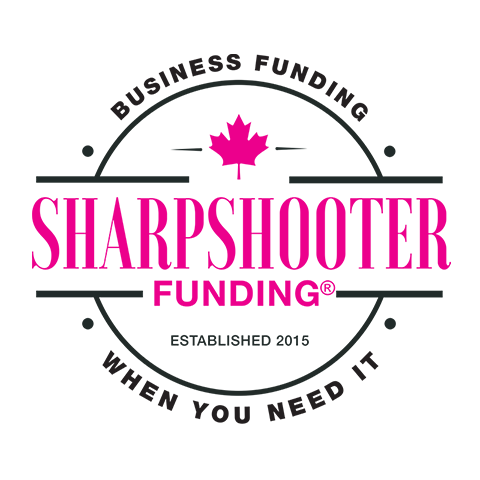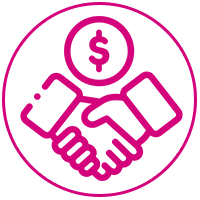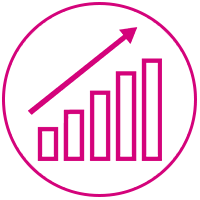Business Line Of Credit
What is a business line of credit?
A Business Line of Credit (BLOC) is a revolving sum of money lent to a business owner at the cost of interest fees. BLOCs are a form of debt financing, in which the owner pays back the borrowed amount over time. A line of credit is different from other types of debt financing. In Canada, these are usually provided by traditional financial institutions – like banks and credit unions. Depending on the institution, business lines of credit either have a fixed cost of working capital or a variable cost of working capital.
In BLOCs the small business owner is granted a pre-approved amount – a credit limit, but the borrower may choose only to use portions of it. The borrower is charged cost of working capitals only on the borrowed amount, not their entire approved amount. It’s like a business credit card but with a much higher credit limit and may not be accessible using a card.
BLOCs are one of the cheapest funding sources your business can receive and if your business qualifies for one, it’s worth considering because you’ll have access to business cash flow when you need it at a lower cost. A business line of credit can be used to help you solve cash flow problems and hire the right supplier for your business.

A business line of credit (BLOC) is a revolving funding that allows access to a fixed amount of capital, which can be used when needed to meet short-term business, needs. A BLOC is one of the tools a business can use to finance short-term working capital requirements, such as:
There are two types of business LOCs:
Support your cash flow and meet your short-term business goals

Access revolving funds
Borrow funds when you need them, up to your approved credit limit. Pay down your balance and access the same line of credit, so you can cover business expenses today or tomorrow.

Pay interest only on what you use
Only pay interest on the funds you use — not on your entire credit limit. Payback the amount you borrow with minimum monthly payments or pay off your whole balance to save on interest.

Take advantage of business opportunities
Ongoing access to funds gives you the flexibility to get trade or inventory discounts and more.
Business lines of credit at a glance
| Line of credit amount | Starting from $10,000 |
| Currency | CAD or USD |
| Cost of working capital | Variable |
| Flexible options | Secured or unsecured |
How do I qualify for a business line of credit?
Meet these requirements and improve your chances of getting approved:
- You have industry experience
- You have personal financial investments in your company
- Your business generates positive revenue, meaning your inflows exceed your outflows, for at least 12 to 24 months
- You have a good credit score
- You have a detailed business plan
More great features
- Use funds whenever you need them, without reapplying — you don’t have to contact us every time.
- Pay off all or part of the balance at any time.
- Access your line of credit by writing a cheque against your CIBC business account, through CIBC online, mobile or telephone banking, ATM withdrawals or at a CIBC Banking Centre.
- Get a combination of borrowing products, such as a funding or overdraft protection, for more flexibility.
Ready to get a business line of credit? We’ll guide you through the process
ARE YOU LOOKING FOR SMALL BUSINESS FUNDING?
We Can Design A Funding Program For Your Small Or Medium Size Business.
Apply Today for FundingWhat You Need to Know About a Business Line of Credit
A business line of credit can be a valuable tool for small businesses that take a strategic approach to making sure they have access to the resources they require to meet day-to-day working capital needs and fill other short-term financial necessities. It allows them to apply and qualify today for borrowed capital they may need down the road. Many businesses use a line of credit as part of a larger capital access approach including short-term and longer-term financing to fuel growth and fund other revenue-generating projects.
A Business Term Funding vs. a Business Line of Credit
From a funder’s perspective (both traditional funders like banks and online funders offer business credit lines) a line of credit and a term funding are very different. For example, when a funder evaluates your creditworthiness for a term funding, they are looking at a business’ credit profile to make a decision about a funding today. For a line of credit, they are looking at a business’ credit performance today, to make decisions about the creditworthiness of the business at some time in the future when it accesses the credit line. To a funder, these are two very different situations and could explain why the qualification process for a line of credit might be a bit more thorough.
That’s not the only difference between a term funding and a line of credit. A term funding involves a fixed amount of funds, which the business receives in a lump sum once the funding is approved. Periodic payments are typically repaid over a defined period of time, or term, in a prearranged schedule of payments until the balance is paid in full.
A business line of credit also includes some additional flexibility that is not part of a small business funding. A LOC is fundamentally a credit limit a business can borrow against whenever they need it, repay, and use again—often for a specified term. Most funders require the LOC balance be brought to zero at some time during the term of the credit line.
LOCs are often used for short-term operating purposes and for more immediate revenue-generating activities because the business can access the funds as needed.

What You Need to Know Before Opening a Line of Credit
Before opening a LOC, make sure you understand your chosen funder’s qualification criteria, funding conditions, cost of working capitals, and fees.
- There may be charges for account set-up, transactions, and annual fees.
- In order to reduce risk, it’s not uncommon for the funder to require the business pay down their outstanding LOC balance to $0 at some point during the year, often for at least 30 days. This assures a funder that the borrower is generating sufficient cash flow to operate independent of the LOC, and not relying on the financing as a substitute for cash flow or owner’s capital.
- Due to the unpredictable nature of the market, a funder might reserve the right to call any LOC payable immediately. This means the full balance would have to be paid and the LOC reduced to zero without warning. If your business depends on the line of credit, this can be a critical impediment, so the business should always be prepared to either replace the LOC or scale back in order to weather the loss of credit.

3 Tips on Keeping a LOC
- Periodically pay down your balance and avoid keeping your average running balance near your credit limit. This will show your funder you know how to leverage the value and flexibility of the LOC.
- Using a LOC to cover operating losses is not the best option—it will make repayment difficult.
- Think strategically about your capital needs for the year to determine the best time to apply for a LOC. Lenders are more inclined to grant a credit line when the business cash flow is strong.
A business line of credit can be a valuable tool to fuel growth and fund other profit-generating initiatives. They offer the financial flexibility to cover gaps in normal cash cycles, can be used to harness resources to maintain year-round business operations for seasonal businesses, and can fund expenses that build value and amplify success in concert with other financial tools.
Revolving Credit vs. Line of Credit: What’s the Difference?
Revolving credit and a line of credit are financing arrangements made between a funding institution and a business or an individual. The funder provides access to funds that the borrower can use at his discretion, like a flexible, open-ended funding. In fact, a revolving credit line is a type of credit line. A line of credit is a one-time arrangement, and when the credit line is paid off, the account is closed.
There are two features of both kinds of lines of credit that make them particularly attractive: purchase flexibility and payment flexibility. Like a credit card, these can be used on an as-needed basis and paid off when it is convenient, depending on terms of the line of credit.
Revolving Credit
Revolving credit is very similar to a credit card; in fact, some institutions refer to a revolving credit agreement as a revolving line of credit. The funding institution grants you a maximum credit limit, which you can use to make purchases at any time and (usually) on any goods.
Many small business owners and corporations use revolving credit to finance capital expansion or as a safeguard in the event of cash flow problems. Individuals might use it for overdraft protection on demand deposit or checking accounts or to cover large, ongoing expenses, like house renovations or medical bills.
If you make regular, consistent payments on a revolving credit account, the funder may agree to increase your maximum credit limit—again, like a credit card. There is no set monthly payment with revolving credit accounts, but interest accrues and is capitalized like any other credit. When payments are made on the revolving credit account, those funds become available for borrowing again. The credit limit may be used repeatedly as long as you do not exceed the maximum.
A home equity line of credit, also called a HELOC, is an example of a revolving credit line. A pre-approved amount of credit is given based on the value of the borrower’s home, making it a secure type of credit. The funds in the account can be accessed in various ways, via check, a credit card connected to the account, or transfer. You only pay interest on the money you use, and the account offers flexibility to draw on the line of credit when needed.
Line of Credit
Non-revolving lines of credit have the same features as revolving credit (or a revolving line of credit). A credit limit is established, funds can be used for a variety of purposes, interest is charged normally, and payments may be made at any time.
There is one major exception: The pool of available credit does not replenish after payments are made. Once you pay off the line of credit in full, the account is closed and cannot be used again.
An example: Personal lines of credit are sometimes offered by banks in the form of an overdraft protection plan. A banking customer can sign up to have an overdraft plan linked to his or her checking account. If the customer goes over the amount available in checking, the overdraft keeps them from bouncing a check or having a purchase denied. Like any line of credit, an overdraft must be paid back, with interest.
Special Considerations
Revolving lines of credit and a line of credit are both different from other traditional funding. Most installment funding, such as mortgages, auto funding, or student funding, have specific purchasing purposes in mind. You must tell the funder what you are going to use the money for ahead of time and you may not deviate from that, unlike a line of credit or revolving credit.
Traditional funding also come with set monthly payments, while most lines of credit do not.
The payments on lines of credit tend to be more irregular, because (unlike a funding) you are not being lent a lump sum of money and charged interest right away. A line of credit is more the ability to borrow funds in the future up to a certain amount; you are not charged interest until you actually start tapping into the line for funds.
Like funding, both revolving credit and non-revolving lines of credit come in secured and unsecured versions. A secured credit is borrowed against a tangible asset, like a house or car, which serves as collateral. As a result, cost of working capitals on secured credit accounts tend to be much lower than those on unsecured credit accounts.
Unsecured lines of credit are usually not your best option if you need to borrow a lot of money. If you plan to make a one-time purchase, consider a personal funding instead of a line of credit. Funding tailored to a specific purchase, such as a home or a car, are often good alternatives to opening a line of credit.





